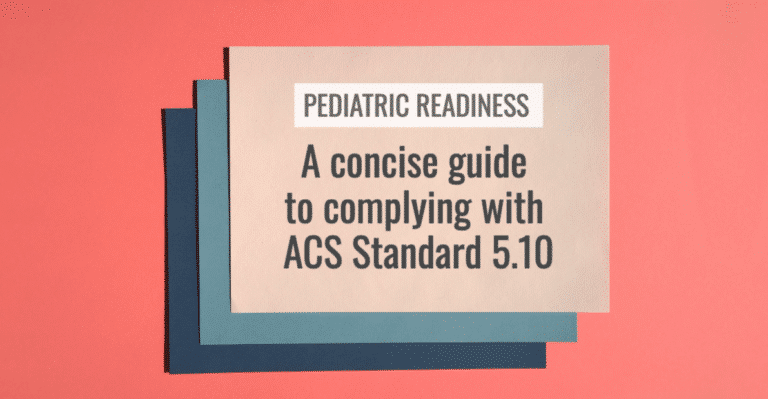Standard 5.10 of Resources for Optimal Care of the Injured Patient: 2022 Standards is designed to ensure that adult trauma centers are prepared to care for injured children. It requires trauma centers to assess the “pediatric readiness” of the emergency department and develop a plan to address identified gaps in readiness. A pediatric readiness assessment must be performed during every verification cycle.

While Standard 5.10 applies to both adult and pediatric trauma centers, it will likely have the greatest impact on non-pediatric hospitals. According to research, five out of six children who need emergency care (83%) present first at an ED that is not a specialized pediatric facility. Improving the readiness of adult trauma centers to care for injured children could have a significant impact on pediatric outcomes.
Reorienting an adult-focused organization to the needs of pediatric patients can be challenging. This article provides a concise guide to complying with Standard 5.10, and it outlines practical recommendations for closing the pediatric readiness gap in your trauma center.
Perform the NPRP assessment, create a gap report and develop an action plan
Standard 5.10 specifies that trauma centers must use the assessment developed by the National Pediatric Readiness Project (NPRP). The NPRP Assessment is available at pedsready.org.
But first, be aware that your hospital’s ED may have already performed the assessment. To find out, talk to ED management in your facility. If there is any uncertainty about your facility’s assessment status, contact the manager of your state’s Emergency Medical Services for Children (EMSC) Program. (For contact information, check the EMSC Grants Database.)
Readiness assessment: The NPRP Assessment includes 82 questions that encompass more than 150 information points. You can perform the assessment online at the NPRP Assessment page or download the PDF version of the NPRP Assessment and use it to perform an “offline” evaluation of your center’s pediatric readiness.
Gap report: Use the results of your center’s assessment to create a pediatric readiness gap report. Essentially, every “no” answer in your assessment represents an opportunity to improve your center’s pediatric readiness.
Action plan: Finally, use your gap report to develop a plan for addressing identified gaps in pediatric readiness. The key is engaging a multidisciplinary team to ensure a holistic perspective. Bring together representatives from emergency medicine, pediatrics, surgery, nursing and other relevant departments (similar to trauma peer review and systems meetings). Collaborative discussions can foster a shared understanding of challenges and allow for the exchange of best practices.
Note that you are not required to implement every recommended structure, process or resource referenced in the NPRP Assessment. In many cases, your action plan will be limited by available staff and budget. However, the overall goal is to develop an action plan that closes the readiness gap as much as possible and ensures seamless coordination of care for pediatric patients.
Identify cost-effective strategies for securing PECCs
One of the most important indicators of pediatric readiness is the presence of a pediatric emergency care coordinator (PECC) or “pediatric champion.” The NPRP recommends that every ED have either a physician PECC, a nurse PECC or both.
This guideline is challenging for most hospitals. Fewer than one out of three EDs have a complete PECC dyad. For many EDs, resource constraints are the underlying issue.
- When creating an action plan around ED pediatric leadership, the first step is to understand the flexibility built into this recommendation. According to the NPRP, the physician PECC does not have to be an MD or DO. The role can be filled by an advanced practice provider, such as a physician assistant or a nurse practitioner. Likewise, the nurse PECC role can be filled by either an RN or an NP.
- In addition, be aware that a PECC does not need to be a separate FTE or new hire. For example, your program’s trauma PI coordinator could take on the role of nurse PECC as part of his or her overall focus on quality improvement.
It is important to note that creating a PECC role is not just an investment in clinical quality — it can also support hospital business strategy. Part of the PECC role for both physicians and nurses can be outreach to community providers regarding pediatric health. Done on a consistent basis, these outreach activities can help grow volume for the ED and other hospital departments.
Create a simple strategy for providing pediatric education in the ED
Staff education in pediatric care is critical to pediatric readiness. If pediatric-specific education is a gap in your center, your action plan should outline a comprehensive training program that caters specifically to pediatric trauma and other pediatric emergencies.
Regular workshops, simulations, case reviews and hands-on mock drills can enhance staff confidence and competence in handling pediatric cases.
Online education modules are available for topics like pediatric assessment, pediatric trauma guidelines and specific injury patterns in children. In general, however, the most effective strategy for providing pediatric education is in situ training.

For example, a pediatric trauma patient is resuscitated and admitted to the floor of an adult trauma center. On day three, concern for sepsis leads to the child being admitted to the ICU. Use a staff debrief to discuss what happened, what signs were missed and what could have been done better.
Pediatric debriefs should take place:
- After any pediatric trauma
- Following any unplanned upgrade in care (e.g., an unplanned ICU admission or transfer)
- Whenever staff express a need for education (e.g., “I did not feel comfortable when…”)
Use these debrief events to create further training during annual or (ideally) quarterly education sessions. This approach ensures staff receive targeted education on low-volume, high-risk issues in pediatric care.
Enhance pediatric QI by incorporating it into regular trauma PI
According to NPRP guidelines, EDs should have a quality improvement (QI)/performance improvement (PI) plan for pediatric patients. One practical option is simply to incorporate pediatric PI into the trauma program’s regular meeting structure.
Start by adding pediatrics as an agenda item to the monthly meeting of the trauma multidisciplinary PIPS committee. Invite a member of the pediatric surgery team to review one case at every session and lead a discussion of opportunities for improvement.
You can also add pediatric PI as an agenda item for the multidisciplinary systems/operations committee meeting. Review pediatric performance metrics and work collaboratively to address systems issues in pediatric care.
Focus on low-cost steps to improve pediatric safety
The NPRP emphasizes the importance of pediatric-focused patient safety practices. The emphasis is on capturing weight in kilograms, capturing full vital signs, and ensuring accurate and safe dosing for children. The following actions will close much of the pediatric safety gap:
Review hospital policies. Do a quick review of hospital and ED policies to ensure they support kilogram-based weighing.
Optimize computer systems. Work with hospital IT to make sure the electronic health record (EHR) captures weights in kilograms by default. Weight-based dosing should also be enabled within the system.
Check weight scales. Check all scales in the ED to make sure they are set to kilograms. In addition, configure the settings to block any attempt to switch a scale back to pounds.
Check tools and resources. Do a sweep of the ED to make sure all tools and resources are up to date with respect to kilogram-based weight and appropriate dosing (for example, Broselow tape measures, quick-reference sheets, pediatric reference books).
Check drugs. Review all the medications given to children in the ED and make sure pediatric-specific dosing is available. For instance, if an anaphylaxis kit is dosed for adults, the nurse will have to perform dosing calculations before it can be used for a child. To speed up care and remove opportunities for error, make sure the ED stocks pediatric-specific anaphylaxis kits.
Check MTP protocols. Many centers have a global massive transfusion protocol (MTP) that must be adjusted on the fly for pediatric use. Work with your blood bank to develop a pediatric-specific MTP.
Adopt pediatric-focused policies, procedures and protocols
A key part of pediatric readiness is ensuring that policies, procedures and protocols reflect the emergency care needs of children.
The Pediatric Readiness in the Emergency Department Checklist specifies several aspects of pediatric emergency care that should be addressed in hospital policy and guidelines. Effective guidelines should cover all stages of care, from triage and assessment to treatment and follow-up.
One good source for pediatric trauma guidelines is the Pediatric Trauma Society’s “Clinical Resources” page. In addition, you may be able to tap other hospital units for assistance. For example, the labor and delivery (L&D) unit likely has a policy on perinatal death. Emergency and trauma leaders can adapt these existing protocols to create a policy for death of a child in the ED.
If your hospital is part of a system, it is important to review guidelines at the system level. Even if there is not a separate pediatric policy, individual policies should include pediatric carve-outs that address the specific needs of children.
Identify existing sources of pediatric equipment, supplies and medications
The greater part of pediatric readiness is simply the availability of pediatric-specific equipment, supplies and medications. In fact, this category accounts for 33 points (out of 100) in the NPRP readiness score.
Begin by conducting an inventory of pediatric-specific equipment and supplies to identify any gaps in resources. According to the most recent study of pediatric readiness, EDs commonly lack infant-sized nonrebreather masks, pediatric-sized Magill forceps, pediatric-specific difficult airway kits and neonatal blood pressure cuffs.

For example, the neonatal intensive care unit (NICU) in your center likely stocks infant endotracheal tubes and related equipment. Similarly, OR inventory may already include child-sized vascular access and monitoring supplies. Other potential sources of pediatric-specific supplies include L&D and (if the hospital is pediatric cardiology center) the Cath Lab.
Supply sharing strategies are ideal for high-cost, low-utilization items. This approach also provides access to staff in other hospital units who know how to use pediatric equipment and supplies and are available to help ED staff provide excellent pediatric care.
Karen Webb, DNP, RN, NEA-BC, NHDP-BC is senior consultant at Peregrine Health Services. If you are interested in learning how Peregrine can help your trauma center comply with ACS standards, visit us at www.peregrinehs.com.


1 Comment
Such a helpful guide! Ensuring pediatric readiness is crucial for better care—thanks for breaking it down so clearly!